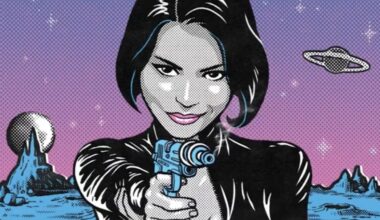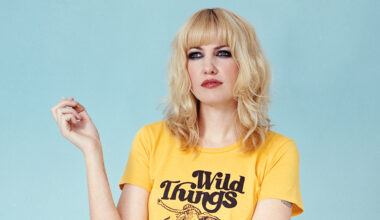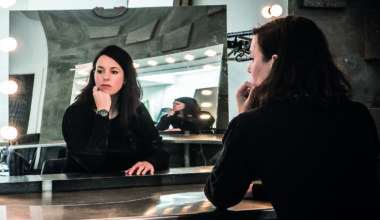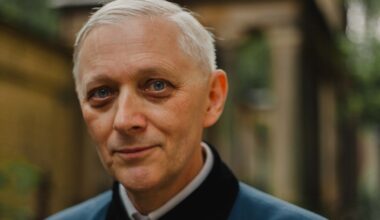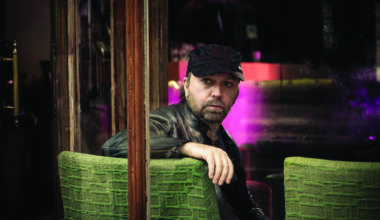To mark the release of a special double CD of her ‘Crackdown Project’, Billie Ray Martin talks about some of the places, people, sights and sounds that have shaped her
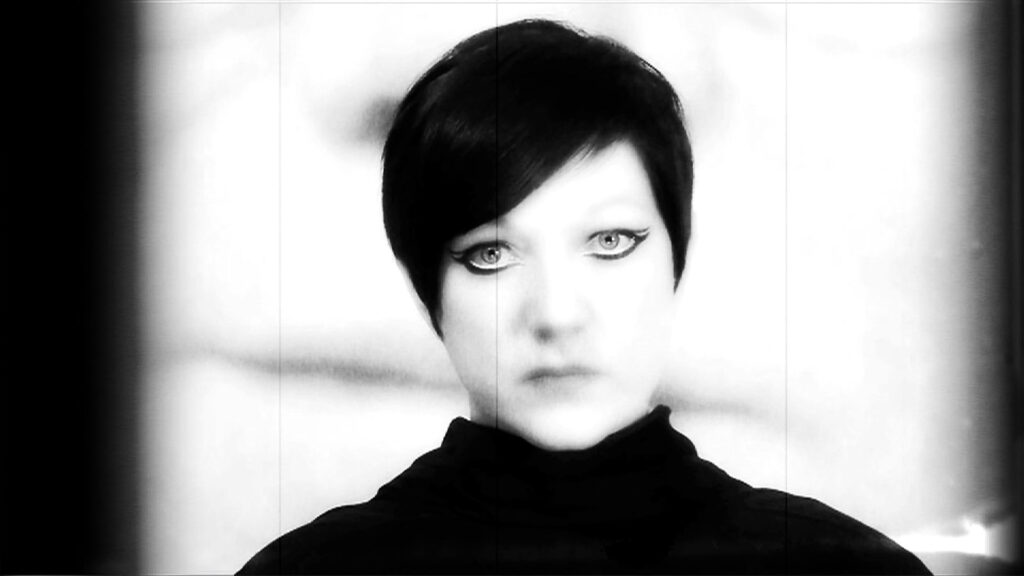
Photo: JOERN HARTMANN
HAMBURG ST PAULI
I grew up in the famous red light district of Hamburg, St. Pauli. I grew up with everything from sailor’s bazaars full of stuffed animals, souvenirs and everything that sailors would bring to Hamburg from their travels, huge ships, trannies and hookers, more canals than Venice, old buildings and a neighborhood feeling at the local market.
Most of all, I grew up with a blurred, or shall we say creative, sense of gender. The women in my family looked like transvestites, with their beehives and huge eyelashes, which they insisted on carrying through the centuries. My mother looked somewhat like Brigitte Bardot, my favourite aunt like a cross between Jayne Mansfield and Marilyn Monroe. My aunts were dressed to the nines every time they appeared in our house, and to a child this meant Hollywood-like glamour and mysterious otherness. A more exciting world had just walked through the door. The hookers, gays and transsexuals were part of the picture as naturally as my grandfather working on a large crane in the industrial part of the harbour, which was like another city in itself.
The sense of openness and excitement was greatly enhanced by my grandmother’s love for Hamburg. I could fill a book with how interesting life in the city was then. Now it is a gentrified glass and steel village for identical-looking yuppie media bots from anywhere but Hamburg, with enough money to rent or buy one of the flats in the hideous apartment blocks that replaced the old oak trees. The smell of money has replaced the smell of soul. I am not opposed to change and modernisation, I am against getting it wrong for greed and corruption, and creating a city with all the disregard for beauty and life imaginable. The pain of the loss of my home lives deep inside me. My song ‘Legends That Die’ is about my family in my birth house in Hamburg and ‘Captain Drag’ is about a Hamburg captain whose ship was taken away from him after his sex change. A true story.
ANDY WARHOL
Andy influences us all. Without him, the world would not look the way it does today. This is not to be underestimated. We keep discovering ever-new things that Andy did “first” and his influence is still growing. Going deep into the nature of his personality, coupled with his creative output, makes one discover the great amount of purpose in his life and art. I’m constantly finding new ideas he had, new aspects of his work that lead to new thought processes and inspirations.
Someone said you can look at a Rembrandt and not think, you can look at any artist’s paintings and not think, but it is impossible to look at an Andy Warhol and not think. This is very true. And it is all the more remarkable in view of Andy’s alleged and self-proclaimed shallowness. My favourite works of Andy’s are not the obvious ones, but the ‘Last Supper’ series he produced in the last year of his life. Critics and archivists are only now discovering the deep meaning hidden behind the symbols he screen-printed onto an image taken from da Vinci’s ‘Last Supper’ painting. Andy had taken such great inspiration from his work with Jean-Michel Basquiat and created this great body of work, once again re-innovating himself and moving forward.
Andy used computers before other artists did, he used cameras to make movies before other artists did… the list is long. Let’s not forget that he did more for gay liberation than anyone else by depicting it openly and without comment in his movies and works of art. Some of his works would probably be banned if they came out today, or would at least cause much outrage. He gave a voice to previously voiceless creatives of all genders and cross-genders and thus created the most exciting art that America has ever known. The personalities he declared superstars live in our imagination today and we adore them for their uncompromising art. Paul Morrissey’s dissing of Andy and talking about his lack of input into his work bores me to tears. Andy was the master and executor of his work, and books are even appearing now about Andy’s collaborations with poets and other areas of art previously unknown about. Morrissey should chew his sour grapes silently instead of loudly.
How Andy influences me exactly I cannot even say. Every aspect of his look, his personality and his art are always there. He was the epitome of cool, and I guess having come out of a Pittsburg ethnic ghetto and achieving what he did only adds to the fascination.
DAVID LYNCH’S ERASERHEAD,
I saw it at the London ICA when I was about 15 years old. Something in my brain rewired that day. I remember coming out of the cinema and remaining in the foyer with friends, discussing what we’d just seen. I wanted to go back at the next opportunity and see it again. I kept suggesting my interpretation of what I’d seen and I kept telling my friends that I couldn’t begin to express what I felt. Lynch going deep into the nature of existence, and way beyond, in his camera work and characters and sets, made for something that somehow changed my life.
About five years later, when I lived in Berlin, a group of us staged an ‘Eraserhead’ performance at Berlin Kant Kino, when the film was showing there. We took over the garage next to the cinema and, after the film, we invited all the movie-goers into our created space. We handed out a worm in a matchbox instead of an entry ticket. Poor worms. Inside, we had a massive bowl filled with salad… and worms. My friend Jacqueline had dressed as half angel, half devil, and had painted her face accordingly, and she performed a mad and intense dance while clutching a big iron wheel that was attached to a wall, which must have been some kind of part of the garage. I believe I was the host and I went around proclaiming lines from the film. I should have performed ‘In Heaven Everything Is Fine’, but I didn’t. Lynch’s work remains an influence on me on a daily basis.
ROMAN POLANSKI
To me, Polanski embodies the darkest part of the human soul. Not Polanski as a person, but the way he interprets and depicts the darkest sides of being alive. Most famously in ‘Rosemary’s Baby’, he shows the depths of horror and isolation created by the evil forces of material gain. His art is psychological; he does not depict images of horror directly – yet the viewer insists they saw the baby.
So it is with Polanski’s other movies. My favourite, ‘The Tenant’, is a masterpiece of this psychology of isolation. It’s the story of a person being driven – or driving himself – to suicide because he loses any idea of who he is. He can no longer tell the difference between imagination and reality, and because this story is cloaked in a seemingly everyday setting, the horror is all the more complete. I believe Polanski knows more about the depths of human isolation than he admits in interviews, in which he often brushes away questions about the horrors he lived through in his life. The isolation that Trelkovski experiences in ‘The Tenant’ resonates within me and Polanski’s other movies inspire me equally, all the way up to ‘Bitter Moon’, which I think is the last good film he made.
I have performed a live score along to Polanski’s ‘Repulsion’ a few times,
at the ICA in London and at the Deutsches Theater in Berlin. I think it’s probably one of my most favourite things I’ve ever done. The song ‘I’m Not Simone Choule’ is about ‘The Tenant’ and I believe it’s one of my more successful efforts.
MUSIC
Musically, I’d say it’s almost impossible to list my main influences. There are simply too many. But artists that changed the way I saw myself and that ultimately made me want to create the kind of music I do include Elton John, Cabaret Voltaire, The Human League, The Sex Pistols, Siouxie Sioux, Martha Reeves & The Vandellas, The Supremes, Ann Peebles, Fingers Inc… But like I say, so very many more.
I saw The Human League in Hamburg as a kid. We’d sneaked out of our homes to see Iggy Pop – who, we were told, was the godfather of punk. What then happened changed everything. The Human League, then unknown, appeared with their stage-set of shelves and their tape machines and their visuals. It was so inspiring, we just stared. None of us had heard or seen anything like it before. Iggy was great, but it was The Human League that blew our minds.
Another band I love are Cabaret Voltaire. They managed to create an atmosphere in their music that put me into a trance.
The combination of the sounds, coupled with Mal’s mysterious and rather sexy voice, put me in a space previously unknown to me. Again as a kid, I saw Siouxie & The Banshees in Hamburg. I had expected a punk band like some others I’d seen, but here was this rather arrogant woman, dressed more like the Thin White Duke than a punk chick. She was gobby and distant and I remember disliking her. It was a little later, when I grew to know the albums, that I became the big fan I am to this day. Her attitude, along with the attitudes of the other punk bands, made me re-think what I could express in life. I turned from a supressed, angry and silent kid, into a supressed, angry and loud one.
MORE MUSIC
I went into a Berlin record shop around the time I was listening to the electronic bands and the young sales assistant asked me if I had ever heard the Motown bands, such as Martha Reeves & The Vandellas and The Supremes. I was aware of them, but hadn’t listened to them that much. He told me he would order a couple of compilations of those two artists for me and, I do not know if he knows this, he changed my life. From the moment I heard Martha Reeves sing ‘Love Love Love’, ‘Heartless’ and other songs, I decided I was going to combine this music and this meaning with electronic sounds. It was more a decision of necessity. I was not going to give up wanting to make electronic music like The Human League, but I had found something to add to it. Hence I started hollering like a soul girl. The sales assistant, Said Djalili, became a part of my first bedroom outfit and we had much fun creating our first tunes.
And then there’s acid house. Well, talking about all the acid house music that influenced me would fill volumes. Let’s just say it all came together right there. The soulful with the repetitive electronic music. Bingo. My time had come.
Billie Ray Martin’s ‘The Crackdown Project’, featuring Cabaret Voltaire’s Stephen Mallinder, is out on Disco Activisto/dPulse Records
